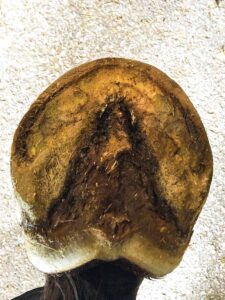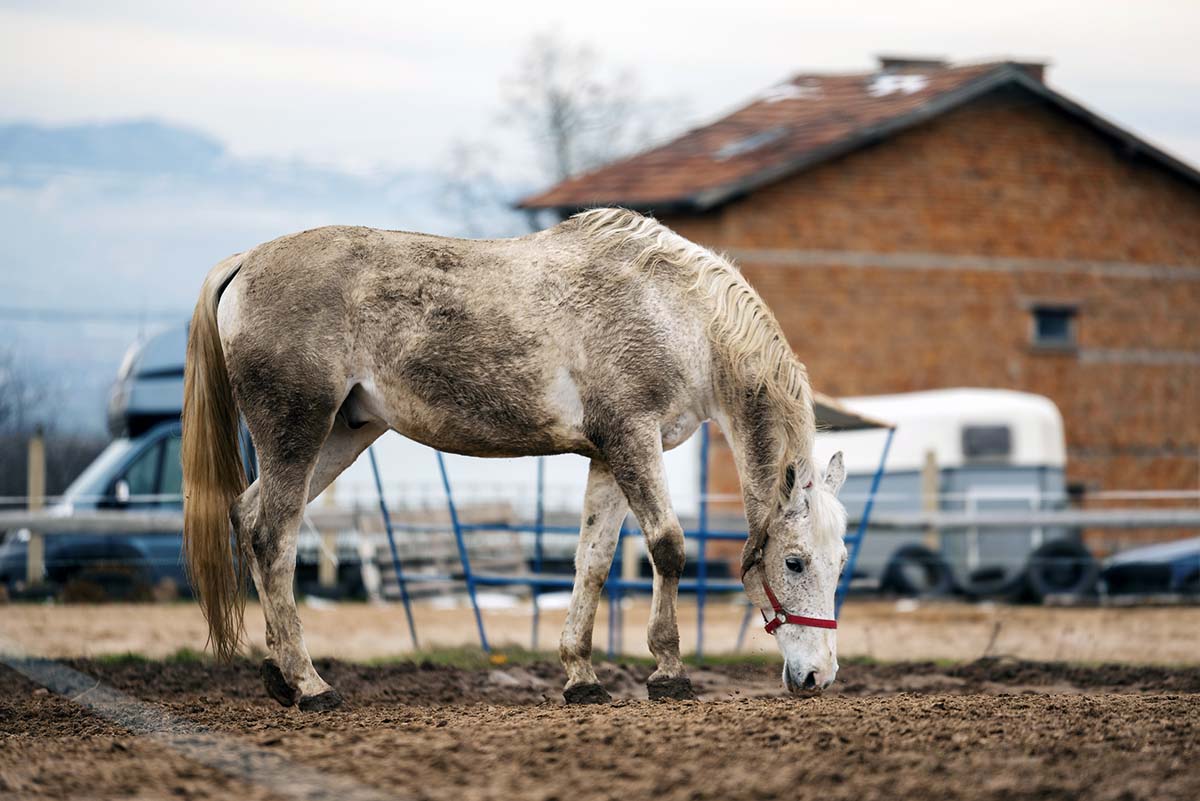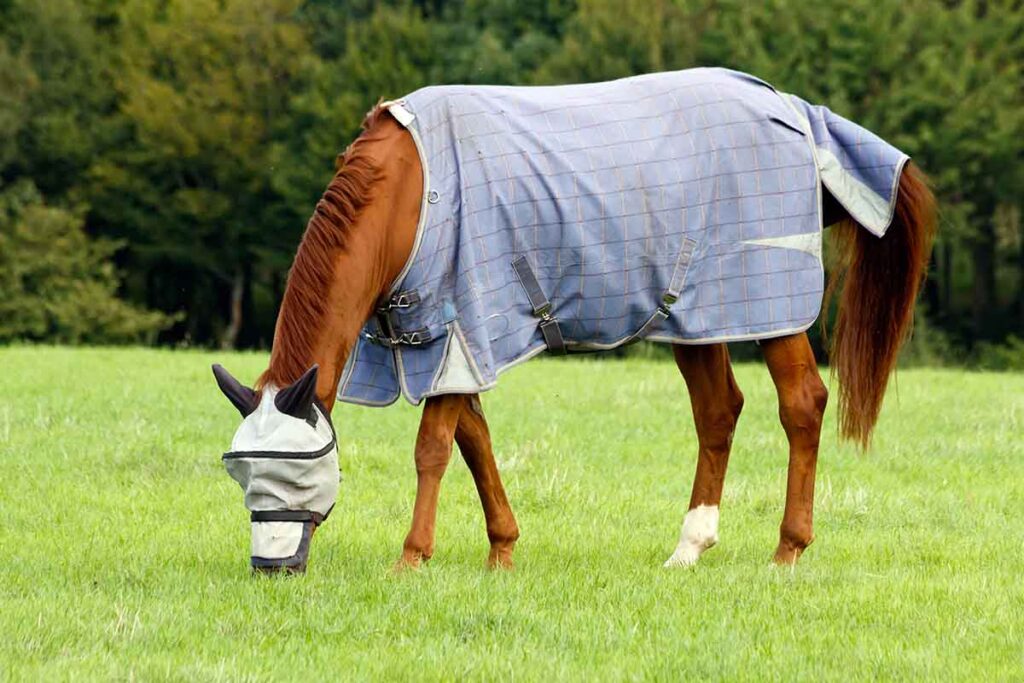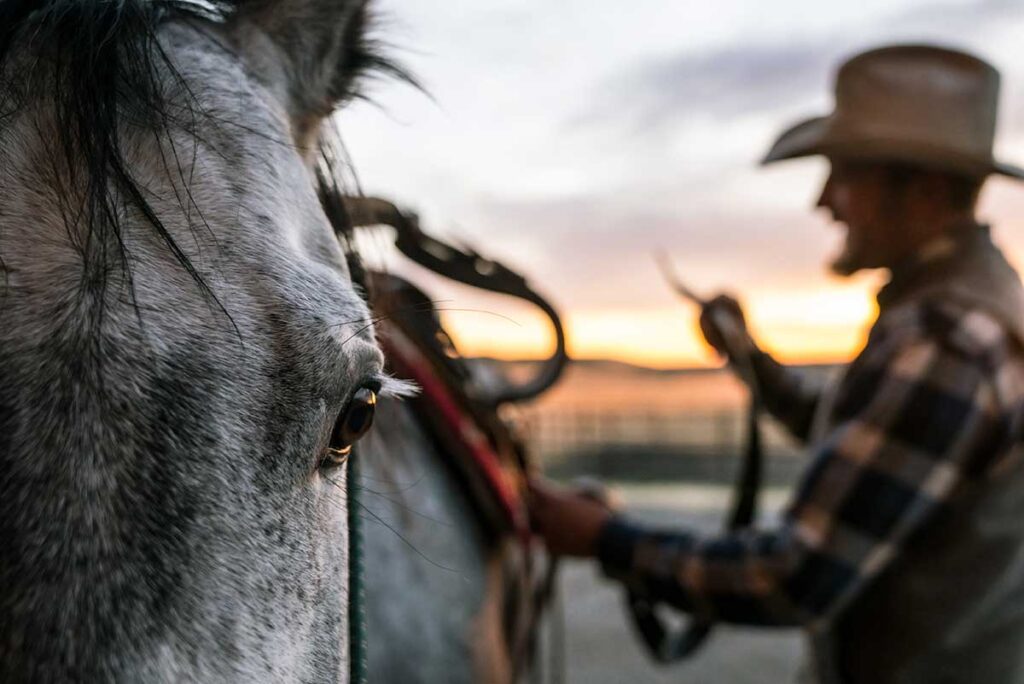You’re working through your normal grooming routine before riding and go to pick out your horse’s hooves. As you clear the dirt and debris from his sole and around the frog, it hits you: What is that terrible smell?! It’s the unmistakable scent of thrush—a common bacterial infection that takes root in the soft tissues on the underside of the hoof. You’ll probably also notice black gunk or goo in the grooves on either side of the frog.
While it looks and smells gross, thrush in horses is typically benign and easy to treat if you catch it early and stay on top of preventive and management methods. In this article, we’ll provide tips for keeping thrush at bay.
What Causes Thrush in Horses?
Thrush thrives where horses are confined in filthy conditions. A horse exposed to “clean” mud that is more or less free of manure and urine isn’t especially likely to develop thrush, but one that stands in urine-soaked bedding for most of the day is a prime candidate. Horses with overgrown or contracted hooves, those that wear hoof pads, and those that get very little exercise are also more susceptible to the condition. Likewise, a horse that is chronically lame as a result of another problem often develops thrush in the hoof of the affected leg.
Some horses are prone to thrush and have recurrent episodes no matter how clean you keep their environment. For these horses, a daily preventive product can help control the problem.
Treating Thrush in Horses

Getting rid of thrush requires an attack on two fronts. First, you need to kill the invading pathogen and—despite what directions on commercial products might say—simply pouring a thrush remedy over the frog will not get the job done. The culprit lives in the many cracks and crevices of the hoof, and a simple splash of liquid will roll right over these hiding spaces.
Here are four easy steps to treat thrush by delivering medication into the areas where it is most needed without damaging surrounding tissues. This technique, which is most effective if applied daily, is suitable whether you use a commercial or homemade preparation.
- Make your own cotton swab by wrapping a wisp of loose cotton tightly around the end of a hoof pick.
- Soak the cotton in treatment solution. We are using a common preparation of half bleach and half glycerin or glycerin-based hand lotion.
- Swab down the sides of the frog as if you were picking out the hoof. The goal is to get into all the cracks, so don’t be afraid to apply a bit of pressure.
- Swab the cleft of the frog and any other crevices in its surface. The swab will become darker as you work, a sign it is picking up exudates and dead tissue. Repeat the process, using fresh cotton, until the swab comes out of the hoof nearly as clean as it went in.
Using a thrush product every day can dry out the frog. Apply your commercial or homemade solution to the hoof a few times a week using the hoof-pick swab technique.
6 Ways to Prevent Thrush
Thrush is usually not debilitating when treated promptly, but it can take diligence to get a stubborn case under control. This is especially true in seasons when the turnout areas stay wet and mucky for weeks. It’s far better to prevent thrush from taking hold in the first place, and that means minimizing the three conditions the infection needs to thrive: constant moisture, an anaerobic (lacking oxygen) environment, and the presence of fungi, bacteria, and other microorganisms. Here are some specific steps to take:
- Provide dry footing. If your turnout areas are constantly wet, bring horses into a barn periodically to give their hooves a chance to dry out. Providing dry run-in sheds and spreading areas of gravel in wet paddocks also allow horses to escape soggy footing.
- Keep stalls and paddocks clean. Manure and urine foster the growth of pathogens. Muck stalls and small turnouts daily.
- Pick out your horse’s feet regularly. Horses that live in larger pastures probably won’t require daily attention. Do check their hooves at least once a week to make sure no problems are developing.
- Stick to a farriery schedule. Horses with hoof imbalances and lameness issues are at higher risk for developing thrush. Regular farrier visits will help keep your horse’s feet healthy and sound.
- Take more care with acidic footing. Chipped or shredded wood is a common choice for bedding in certain areas of the country. However, some trees, especially conifers, tend to be acidic. When these materials decompose in wet paddocks, they can change the pH of the soil and foster the growth of bacteria that cause thrush as well as abscesses. If you use these materials, be extra vigilant in monitoring the health of your horse’s feet.
- Make sure your horse gets plenty of exercise. With every step a horse takes, his hooves expand and contract. This constant flexing pushes out dirt and debris. Horses that stand for long periods in manure-laden footing are more likely to develop thrush. If regular turnout is not an option, hand-walking or riding the horse over dry ground will help clean his feet.
Take-Home Message
Regular hoof-picking will help you detect and treat bouts of thrush before they become serious. If you can’t get a handle on a prolonged infection or your horse becomes lame, call your veterinarian. To prevent thrush from invading in the first place, resolve to keep cleaner, drier stalls and increase your horse’s exercise time. Better yet, try continuous turnout in a clean field. Not only will these changes help clear up a case of thrush, but they can prevent its return.
Watch: How To Pick Out a Horse’s Hoof
Portions of this article originally appeared on Equusmagazine.com.
Are you enjoying this content? Sign up for My New Horse’s FREE newsletter to get the latest horse owner info and fun facts delivered straight to your inbox!








